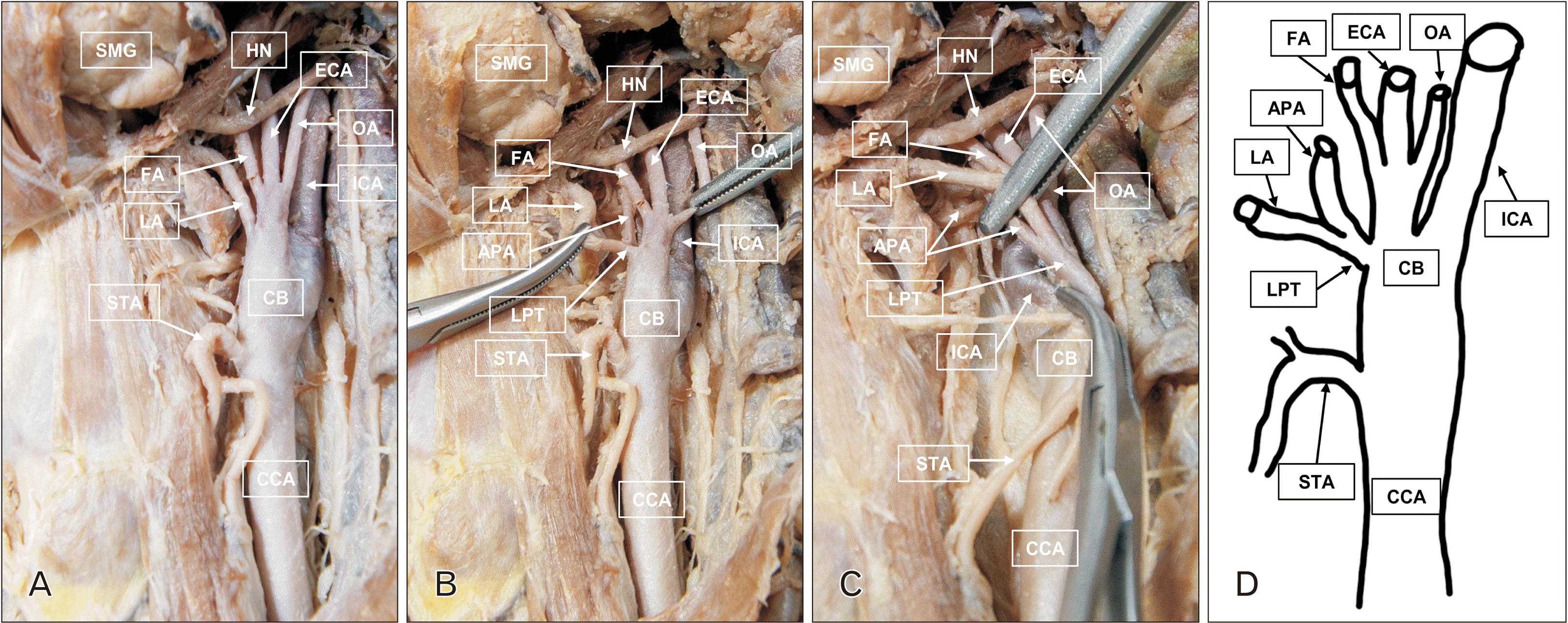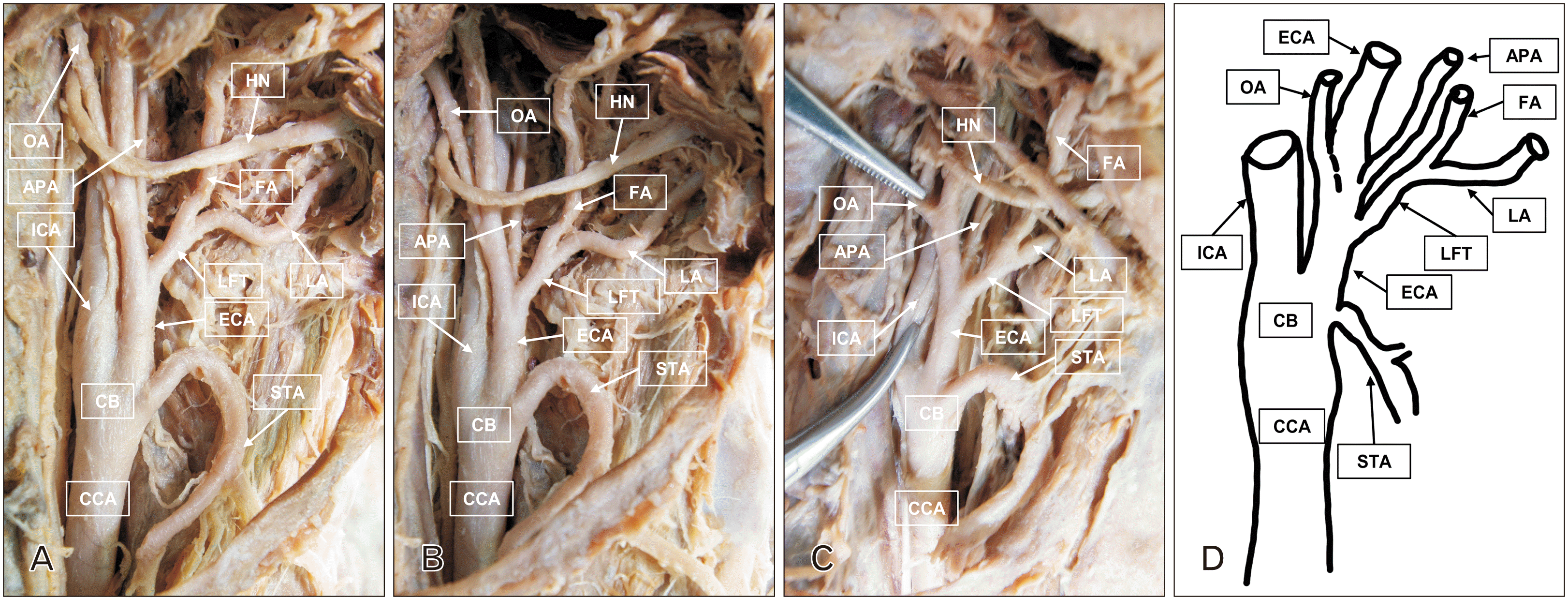This article has been
cited by other articles in ScienceCentral.
Abstract
Comprehensive understanding of the variations in the branching of the external carotid artery (ECA) is essential to minimizing vascular complications during cranio-facial and neck surgical procedures. We demonstrate a rare case of unusual branching of ECAs in both carotid triangles and anomalous origin of the left ascending pharyngeal artery (APA) during dissection of embalmed cadaver. The right and left common carotid arteries (CCA) bifurcated at the level of the upper border of the thyroid cartilage. The right superior thyroid artery (STA) originated anterior to the carotid bifurcation (CB), while the left STA originated from the anterior aspect of the left CCA. The right ECA trifurcated into linguofacial trunk, APA, and distal ECA, 15.7 mm from CB. On the left side, lingual artery and APA arose as a short common linguopharyngeal trunk, 1.9 mm from CB. The left facial and occipital arteries originated anteromedially and posteriorly at the same level.
Go to :

Keywords: External carotid artery, Ascending pharyngeal artery, Linguofacial trunk, Superior thyroid artery, Linguopharyngeal trunk
Introduction
The external carotid artery (ECA) with its branches is the major source for blood supply in the neck and head regions. Normally, it arises from the common carotid artery (CCA) together with the internal carotid artery (ICA) at the level of the superior border of the thyroid cartilage. Usually, the ECA gives eight branches: superior thyroid artery (STA), lingual artery (LA), and facial artery (FA) from its ventral surface; from its posterior surface arise the occipital artery (OA) and posterior auricular artery; the ascending pharyngeal artery (APA) from its medial surface; the maxillary artery and superficial temporal artery as terminal branches [
1]. Despite this classic textbook representation, numerous variations in the branching pattern of the ECA have been described [2–9]. The origin of ventral branches of the ECA in the form of common trunks, such as thyrolingual (TL), linguofacial (LFT), thyrolinguofacial (TLF), occipitoascendingpharyngeal, and occipitoauricular, has also been discussed [
10,
11]. We demonstrate a rare case of unusual branching of the ECAs in both carotid triangles and anomalous origin of the left APA.
A comprehensive understanding of the variations in the branching of the ECA is crucial for minimizing vascular complications during surgeries (thyroidectomy, laryngectomy, tonsillectomy, glossectomy, etc.), ligating the ECA or its branches in severe epistaxis, arterial angiograms, embolization, and intra-arterial chemotherapy.
Go to :

Case Report
During routine academic dissection of the neck region of an embalmed female cadaver, the carotid triangles were carefully dissected and bilateral anatomic variations of the branches of the ECA were determined. The cadaver was property of the Department of Anatomy, Histology, Cytology and Biology, Medical University – Pleven and all procedures complied with the ethical principles outlined in the Declaration of Helsinki of 1975 (revised 2013;
https://www.wma.net/policies-post/wma-declaration-of-helsinki-ethical-principles-for-medical-research-involving-human-subjects/). The authors sincerely thank those who donated their bodies to science. The origin of the caudal branches of the ECA was detected, photographed, and the distance between the origin of each artery and the carotid bifurcation (CB) was measured by vernier caliper (the cadaver remained in the supine position without any tension on the neck region).
The left and right CCAs were bifurcating into ECA and ICA at the level of the superior border of the thyroid cartilage of the larynx.
On the left side, the STA was found to arise from the anteromedial surface of the CCA, 14.8 mm below the CB (
Fig. 1A, B, D). The LA and APA arose as a short common linguopharyngeal trunk (LPT). The distance of the LPT origin from the CB was 1.9 mm (
Fig. 1B–D). The length of the LPT was 1.3 mm and it branched into left LA and left APA (
Fig. 1C). To our knowledge, this is the first report of a common LPT. The left FA and OA originated anteromedially and posteriorly at the same level, 3.2 mm above the CB (
Fig. 1A, B, D).
 | Fig. 1Photographs (A–C) and illustration (D) of the branches of the left ECA. (A) native state of the left ECA with all visible caudal branches. (B, C) Demonstration of the short LPT emerging anteromedially from the ECA. (D) drawing representing all caudal branches of the left ECA. SMG, submandibular gland; HN, hypoglossal nerve; ECA, external carotid artery; OA, occipital artery; FA, facial artery; ICA, internal carotid artery; LA, lingual artery; STA, superior thyroid artery; CB, carotid bifurcation; CCA, common carotid artery; APA, ascending pharyngeal artery; LPT, linguopharyngeal trunk. 
|
On the right side, the STA originated anterior to the CB (
Fig. 2A–D). Then, 15.7 mm from the CB, the right ECA trifurcated into the LFT, APA, and distal ECA (
Fig. 2C, D). The LFT originated anteromedial to the ECA, and its length was 8.3 mm (
Fig. 2A–D). The APA originated posteromedial to the ECA (
Fig. 2C, D). The distance of the OA origin from the CB was 30.7 mm and it arose posteromedial to the distal ECA (
Fig. 2A, C, D).
 | Fig. 2Photographs (A–C) and illustration (D) of the branches of the right ECA. (A) native state of the right ECA with all visible caudal branches. (B, C) Demonstration of the trifurcation of the ECA into LFT, APA, and distal ECA. (D) drawing representing all caudal branches of the right ECA. HN, hypoglossal nerve; OA, occipital artery; APA, ascending pharyngeal artery; FA, facial artery; ICA, internal carotid artery; LFT, linguofacial trunk; LA, lingual artery; ECA, external carotid artery; CB, carotid bifurcation; STA, superior thyroid artery; CCA, common carotid artery. 
|
Go to :

Discussion
The CB represents an important anatomical and surgical landmark. The bifurcation of the CCA was reported to be at the level of the superior border of the thyroid cartilage in 50% to 75% of the cases; at the level of the hyoid bone in 25% to 38% of the cases; only few cases were described with low level of the CCA bifurcation [
2,
9,
11,
12]. Higher level of the CB was associated with great degree of anatomical variability in the branches of the ECA [
11,
12]. In our case the CB was at the usual level – the superior border of the thyroid cartilage.
The STA could arise from the CCA (40%), CB (40%) and ECA (20%) either independently, or from TL or TLF trunks (16.7%) [
13]. In this study, the right STA arose from the CB on the right side and from the CCA on the left side.
The presence of common trunks originating from the CCA has been frequently described [
10,
11]. The LFT has been described in around 20% of all cases, being the most common variation. In the presents study, LFT was observed on the right side. Other common trunks as TL, TLF, occipitoascendingpharyngeal, and occipitoauricular, has also been discussed [
9]. The APA usually arises as a separate branch from the ECA but is found to share common trunk with the OA in 24.32% of cases [
9]. Here, we identified a short 1.3 mm common LPT which branched into LA and APA. The presence of such trunk was not previously identified according to the available literature, so it might be a very rare variation.
Development of the ECA system is a complicated process of angiogenesis and remodeling in which regression and annexation of vessels occurs. The described variations will result in deviation from this process.
Increasing the knowledge of rare variations in the branching pattern of the ECA and their combinations will provide further insight for surgeons and interventional radiologists to avoid iatrogenic vascular injuries during procedures on the neck and head regions.
Go to :







 PDF
PDF Citation
Citation Print
Print



 XML Download
XML Download